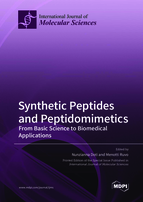Synthetic Peptides and Peptidomimetics: From Basic Science to Biomedical Applications
A special issue of International Journal of Molecular Sciences (ISSN 1422-0067). This special issue belongs to the section "Biochemistry".
Deadline for manuscript submissions: closed (30 November 2021) | Viewed by 43615
Special Issue Editors
Interests: peptides; peptidomimetics
Special Issues, Collections and Topics in MDPI journals
Interests: monoclonal antibodies; antibody functional fragments; antibody drug conjugates
Special Issues, Collections and Topics in MDPI journals
Special Issue Information
Dear colleagues,
Synthetic peptides are gaining increasing interest as both research tools in basic and applied science and as therapeutic and diagnostic agents in clinical settings. Their use as inhibitors of protein–protein interactions is becoming a common practice toward elucidating the binding mode of proteins, advancing our understanding of signaling cascades, and offering a viable contribution to the design and development of new drugs. Synthetic peptides are also ideal ligands for extracellular receptors, acting as potent activators of several cellular pathways such as those of the immune response. To date, about 60 peptides have been approved for human use worldwide, many of which are derived from natural molecules, and hundreds more are progressing through the different stages of clinical trials. However, the poor membrane permeability, short plasma half-life, and scarce oral bioavailability strongly limit their druggability and negatively impact on clinical aspects. In this scenario, novel structural modifications are continuously sought for improving pharmacokinetic properties. Among others, amino acid or backbone modifications and the introduction of non-natural amino acids and conjugation of chemical moieties that extend the half-life, improve cellular uptake, stabilize active conformations, and modulate solubility are constantly proposed. Given the high biocompatibility, generally low toxicity, and functionalization potential, peptides and peptidomimetics are also being increasingly employed to develop new functional biomaterials which are excellent cell culture substrates for medicinal applications or that may act as biorecognition elements for the detection of analytes such as proteins, nucleic acids, and pathogens. In this instance, peptides are also being used as recognition units for chip-based biosensors for clinical diagnosis.
We therefore invite academic and industrial investigators working in all these fields to submit original research articles or reviews describing and discussing the most recent advancements and developments in basic science and biomedical applications.
Potential topics include, but are not limited to:
- Synthetic peptides and peptidomimetics as protein–protein inhibitors
- Synthetic procedures for preparing peptides and peptidomimetics
- Biochemical and biophysical characterization of peptides and peptidomimetics
- Peptide-based bioconjugation
- Nanoparticle-conjugated peptides
- Peptide-based bioreceptors
- Peptide-based biomaterials
Dr. Nunzianna Doti
Dr. Menotti Ruvo
Guest Editors
Manuscript Submission Information
Manuscripts should be submitted online at www.mdpi.com by registering and logging in to this website. Once you are registered, click here to go to the submission form. Manuscripts can be submitted until the deadline. All submissions that pass pre-check are peer-reviewed. Accepted papers will be published continuously in the journal (as soon as accepted) and will be listed together on the special issue website. Research articles, review articles as well as short communications are invited. For planned papers, a title and short abstract (about 100 words) can be sent to the Editorial Office for announcement on this website.
Submitted manuscripts should not have been published previously, nor be under consideration for publication elsewhere (except conference proceedings papers). All manuscripts are thoroughly refereed through a single-blind peer-review process. A guide for authors and other relevant information for submission of manuscripts is available on the Instructions for Authors page. International Journal of Molecular Sciences is an international peer-reviewed open access semimonthly journal published by MDPI.
Please visit the Instructions for Authors page before submitting a manuscript. There is an Article Processing Charge (APC) for publication in this open access journal. For details about the APC please see here. Submitted papers should be well formatted and use good English. Authors may use MDPI's English editing service prior to publication or during author revisions.








